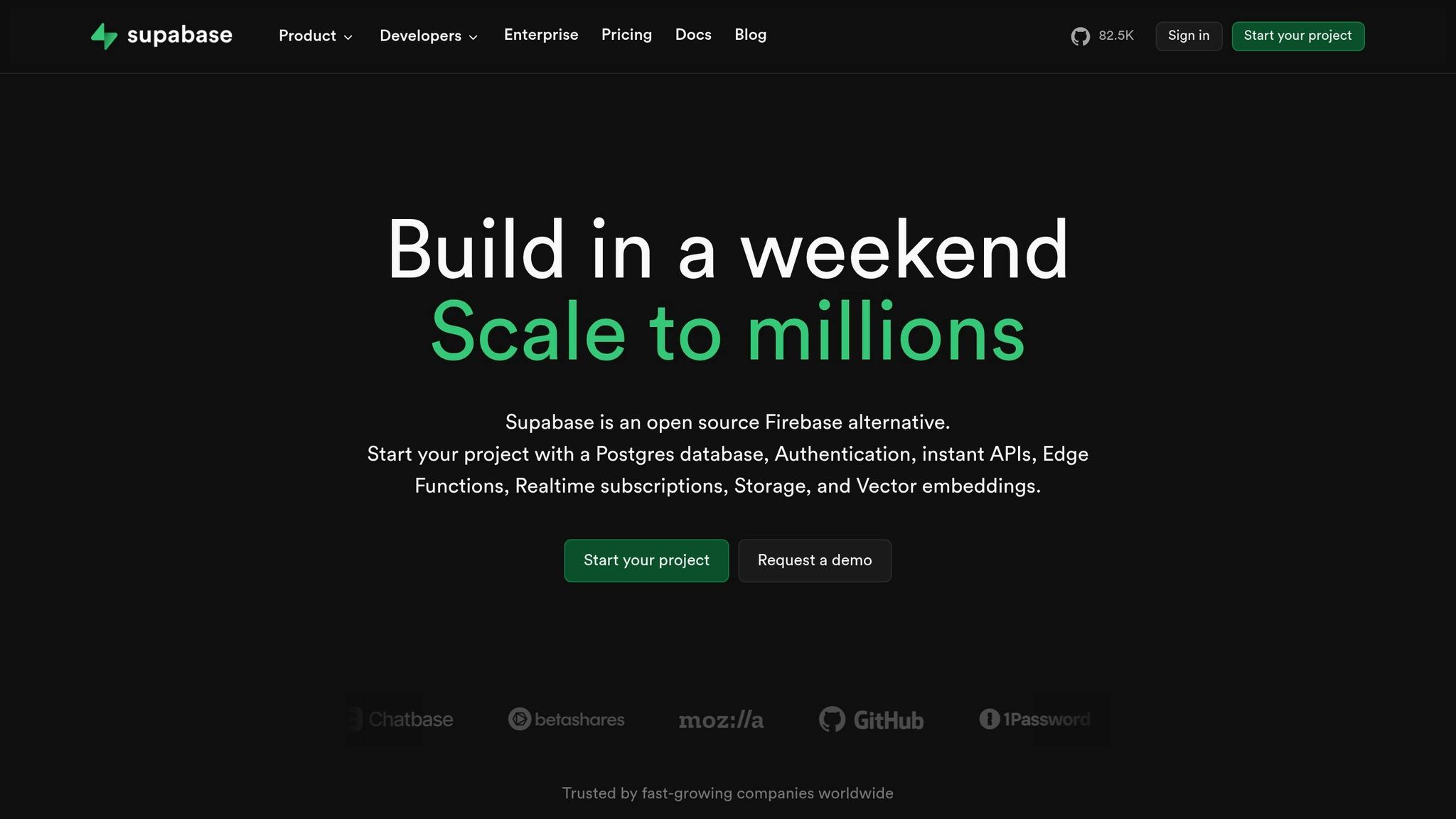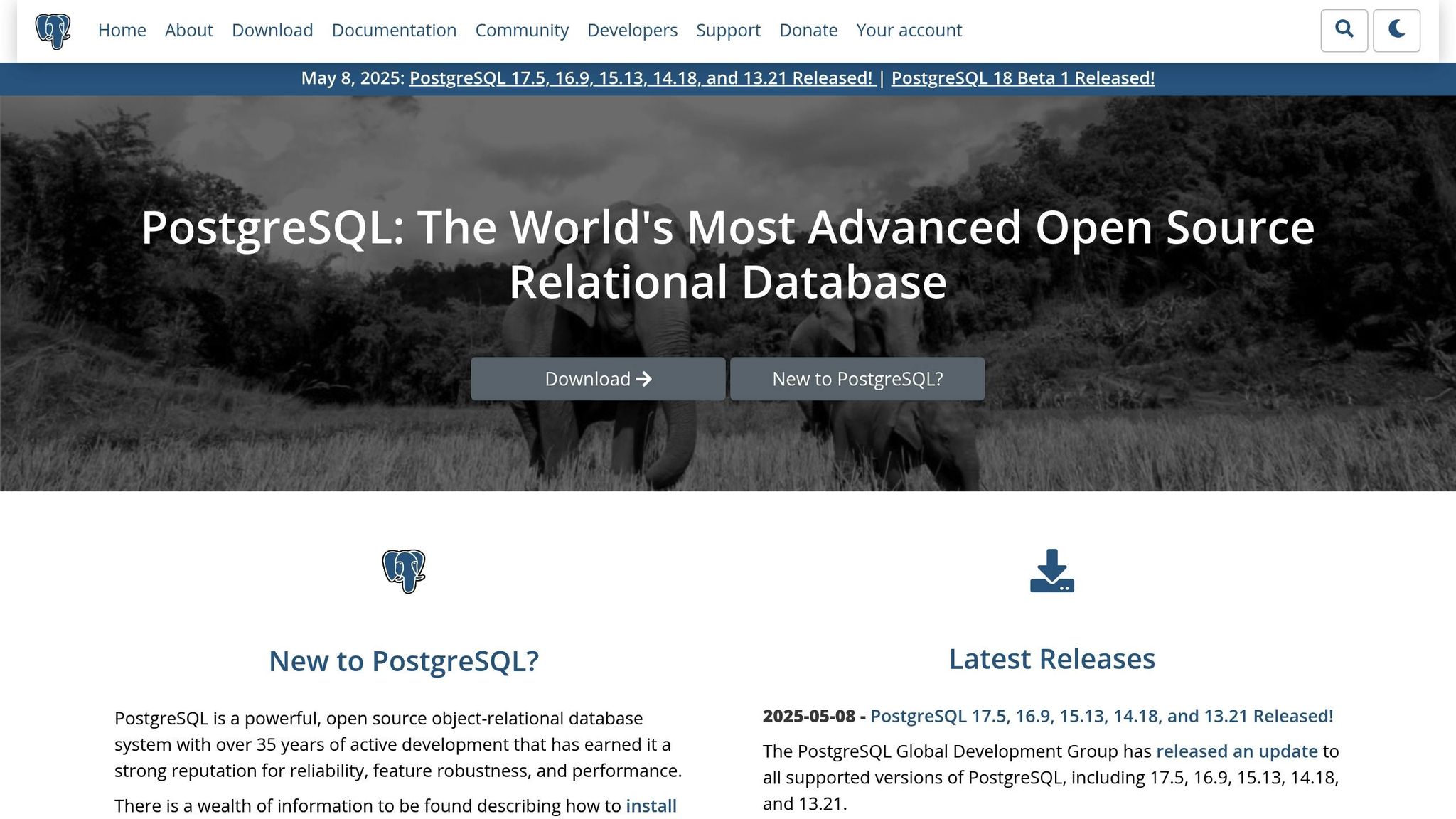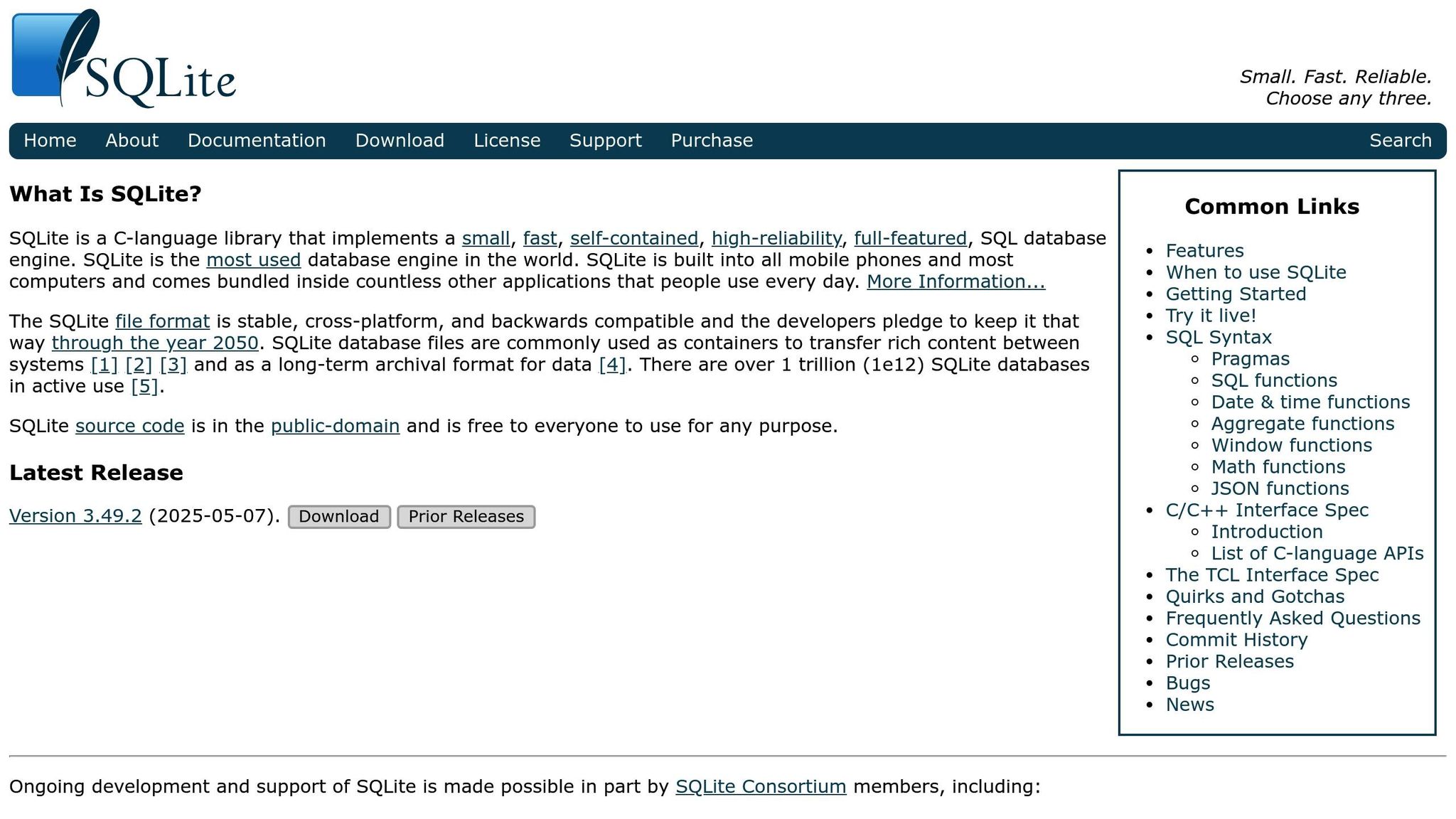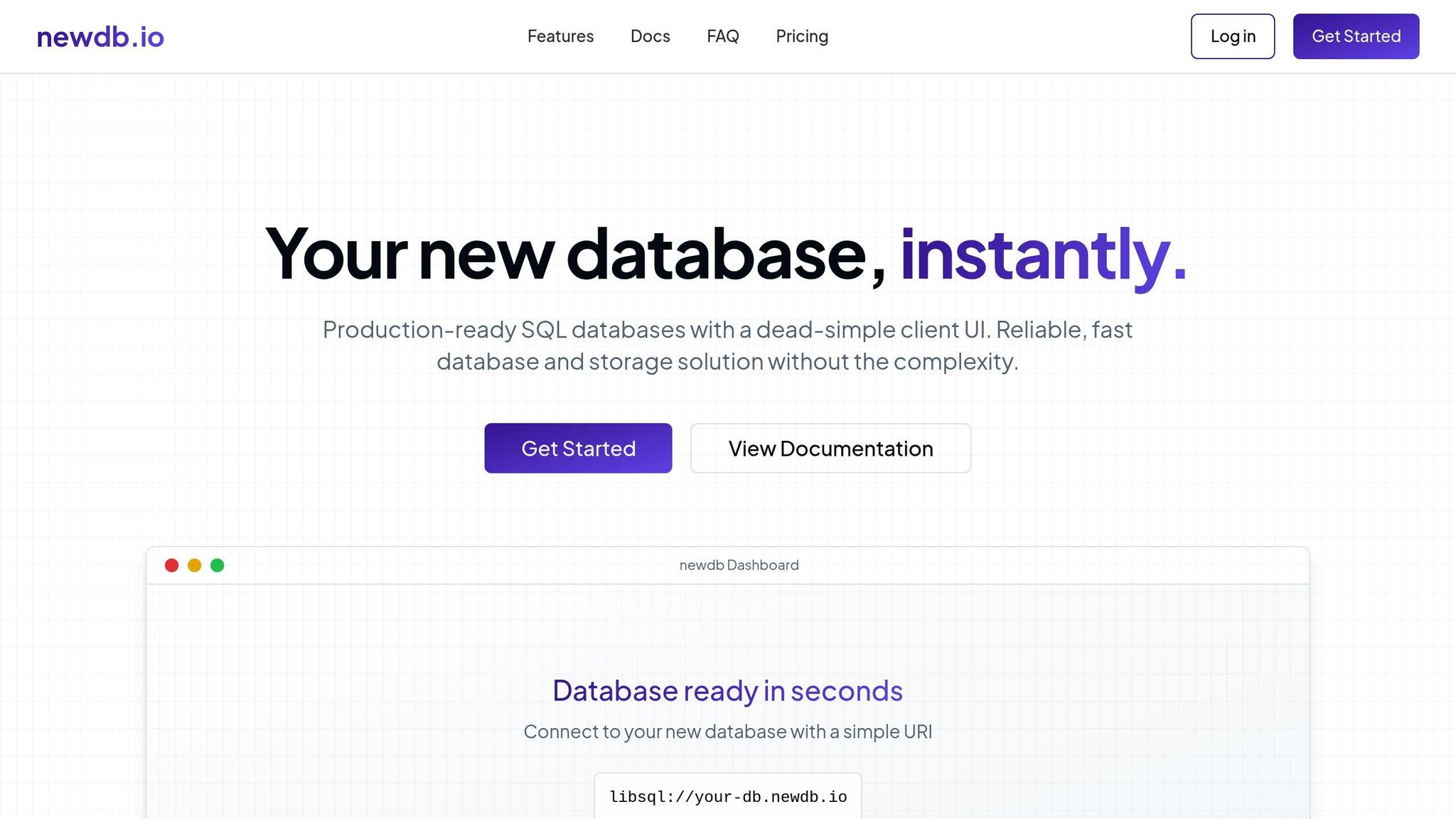
Quick Setup: 5 Affordable Database Solutions for React Projects
Choosing the right database for your React project can save time and improve performance. Here’s a quick look at five affordable options that are easy to set up and integrate with React:
- Firebase Realtime Database: Free up to 1GB, real-time sync, great for collaborative apps.
- Supabase PostgreSQL: Free tier available, SQL power with built-in authentication and real-time features.
- Railway-PostgreSQL: Pay-as-you-go pricing, scalable for small to production-grade apps.
- SQLite with React Native: Free, lightweight, ideal for offline-first mobile apps.
- newdb.io SQL Platform: Free plan available, instant setup, and REST API-friendly.
Quick Comparison
| Database | Starting Price | Free Tier Storage | Best For | Offline Support | Real-Time Support |
|---|---|---|---|---|---|
| Firebase Realtime | Free up to 1GB | 1 GB | Real-time apps | Yes | Built-in |
| Supabase PostgreSQL | Free tier | 500 MB | SQL-based web apps | Limited | Via extensions |
| Railway-PostgreSQL | $5/month | 1 GB | Scalable production apps | No | Manual setup |
| SQLite (React Native) | Free | Device storage limit | Offline-first mobile apps | Yes | No |
| newdb.io SQL Platform | Free plan | Plan-dependent | Prototypes and MVPs | Yes | Basic |
Each option caters to different needs, whether you’re building a mobile app, a real-time web app, or a scalable production project. Read on for detailed insights on setup, pricing, and use cases.
React Supabase CRUD Tutorial | Supabase Beginner Tutorial

1. Firebase Realtime Database

Firebase Realtime Database makes managing data in React projects straightforward, offering real-time synchronization with minimal setup.
Setup and Integration
Start by creating a Firebase project, grabbing your API keys, and initializing the Firebase SDK in your React app. This setup should happen once at the top of your component tree to ensure everything runs smoothly.
For added security, store your Firebase configuration details in a .env file and include this file in .gitignore to keep sensitive credentials safe.
Cost Structure and Scaling
Firebase offers a pricing model that supports small to medium-sized React apps:
| Resource Type | Free Tier Limit | Overage Rate |
|---|---|---|
| Simultaneous Connections | 200,000 per database instance | 100 connections limit |
| Storage | 1 GB | $5/GB beyond free tier |
| Data Downloaded | 10 GB per month | $1/GB beyond free tier |
Here are a couple of examples to give you a better idea:
- A small React app with 50 concurrent users, 500 MB of storage, and 5 GB of monthly downloads would likely stay within the free tier.
- A larger app handling 150,000 concurrent users, 2.5 GB of storage, and 15 GB of monthly downloads might incur a monthly cost of around $12.50 ($7.50 for storage and $5.00 for downloads).
Data Management Features
Firebase's JavaScript SDK supports all the usual CRUD operations and offers some standout features:
- Real-time Updates: Listeners ensure data changes are instantly synced across all connected clients.
- Flexible Data Structure: You can use both flat and nested data structures, though flat structures are generally better for query performance.
- Security Rules: Built-in tools allow you to control data access based on user authentication.
To manage data effectively, make use of methods like push(), set(), update(), and remove().
Performance Optimization
As your React app grows, keep performance in check with these strategies:
- Use multiple database instances when nearing connection limits.
- Index data paths that are queried frequently.
- Structure data to avoid unnecessary downloads.
-
Clean up listeners with the
off()method to maintain efficiency.
Up next, we’ll explore another database option that fits well with React applications.
2. Supabase PostgreSQL

Supabase PostgreSQL is a backend-as-a-service platform that simplifies database setup for React applications. Packed with features like built-in authentication, storage, and real-time functionality, it’s a go-to choice for developers looking to deploy quickly without compromising on capabilities.
Setup Process
Getting started with Supabase is straightforward:
-
Project Creation and Configuration
Begin by creating a Supabase project at database.new. Then, set up a React app using Vite with the following commands:
npm create vite@latest my-app -- --template react npm install @supabase/supabase-js -
Database Configuration
Use the SQL Editor in Supabase to define your database schema. For example, you can create a table for storing instrument data with this SQL command:
CREATE TABLE instruments ( id SERIAL PRIMARY KEY, name TEXT, type TEXT ); -
React Integration
Save your Supabase credentials in a
.env.localfile to keep them secure:VITE_SUPABASE_URL=your-project-url VITE_SUPABASE_ANON_KEY=your-anon-key
Pricing Structure
Supabase offers flexible pricing options to accommodate projects of varying sizes. Here's a quick comparison:
| Feature | Free Tier | Pro Tier | Team Tier |
|---|---|---|---|
| Database Size | 500 MB | 8 GB included | 8 GB included |
| Monthly Active Users | 50,000 | 100,000 | 100,000 |
| Storage | 1 GB | 100 GB | 100 GB |
| Edge Functions | 500,000 calls | 2M calls | 2M calls |
| Real-time Connections | 200 peak | 500 peak | 500 peak |
Performance Features
Supabase PostgreSQL is designed for speed, delivering up to 4x faster performance. This is achieved through several key features:
- Native PostgreSQL Support: Direct database access eliminates the need for middleware, reducing latency.
- Real-time Subscriptions: Instantly sync data updates across all connected clients.
- Row Level Security: Built-in policies ensure fine-grained control over who can access specific data.
Data Management
The Supabase client library makes it easy to interact with your database directly from React components. Here’s a quick example:
const { data, error } = await supabase
.from('table_name')
.select()
.order('column_name', { ascending: true })
.limit(10);
Tips for optimizing data operations:
- Use prepared statements for queries you run frequently.
- Enable connection pooling to manage resources efficiently.
- Add indexes to columns that are queried often.
- Cache results of common queries using React’s state management tools.
Next, we’ll take a closer look at Railway-PostgreSQL, another scalable database solution.
3. Railway-PostgreSQL

Railway-PostgreSQL combines ease of use with advanced capabilities, offering a solid database solution for React applications. It’s designed to handle both small-scale projects and demanding production environments, making it a versatile choice for developers.
Deployment Options
Railway offers two PostgreSQL deployment setups to suit different needs:
| Feature | Instance Type | High Availability (HA) Cluster |
|---|---|---|
| Node Configuration | Single PostgreSQL node | Three PostgreSQL nodes with replication |
| Best For | Development and small apps | Production workloads |
| Load Balancing | Simple round-robin | Pgpool-II proxy service |
| Fault Tolerance | Limited | Multi-region deployment (US West, US East, EU West) |
Scaling Architecture
Railway’s internal orchestrator, built on Temporal, handles service replication and workload distribution seamlessly. Developers can easily adjust the number of service replicas through a simple control, ensuring both flexibility and reliability. This architecture naturally scales into a high availability setup, ideal for production environments.
High Availability Setup
The High Availability (HA) Cluster is designed for maximum reliability and includes:
- Replication Across Three PostgreSQL Nodes: Managed by Repmgr to handle automated failover.
- Pgpool-II Proxy Service: Ensures efficient connection pooling and load balancing.
- Multi-Region Deployment: Spanning US West, US East, and EU West for enhanced fault tolerance.
- Network Flexibility: Supports both public and private network load balancing.
This setup ensures that mission-critical applications maintain uptime and performance, even under heavy workloads.
React Integration Tools
Railway makes it easy to integrate PostgreSQL with React, offering tools that simplify backend communication:
- GraphQL API Access: Developers can use Railway’s public GraphQL API to build custom autoscaling and monitoring solutions directly into their React projects.
- Connection Management: For HA deployments, React apps connect via the Pgpool-II proxy service, which handles connection pooling and balances the load for consistent performance.
Development Tips
For developers using Railway-PostgreSQL, here are some practical suggestions:
- Scale horizontally when your application demands it.
- Use connection pooling to optimize resource usage.
- Take advantage of the GraphQL API for custom monitoring and scaling solutions.
- Choose the HA cluster for production to ensure reliability and fault tolerance.
Railway is continuously improving its platform, with upcoming features like built-in autoscaling and scaling-to-zero capabilities. These enhancements make it an appealing choice for React developers who need a database solution that grows with their needs.
sbb-itb-687e821
4. SQLite with React Native

SQLite is a lightweight, serverless database system that's a natural fit for React Native apps. Its simplicity, combined with built-in data persistence, makes it ideal for mobile applications that need reliable local storage.
Setup and Integration
Getting SQLite up and running in React Native is straightforward. Start by installing the necessary package:
npm install --save react-native-sqlite-storage
If you're working on an iOS project with React Native 0.60 or later, complete the setup with:
cd ios && pod install && cd ..
Performance Specifications
SQLite is designed to handle a variety of use cases with clear performance limits:
| Specification | Limit |
|---|---|
| Maximum Database Size | 281 TB |
| Maximum String Length | 2.1 GB |
| Maximum Columns per Table | 2,000 |
| Maximum Tables in Join | 64 |
| Default Page Size | 4,096 bytes |
Data Management Best Practices
To ensure smooth performance when using SQLite in React Native, consider these practices:
-
Transaction Management: Grouping database operations into transactions can significantly boost performance. For example:
await db.transaction(tx => { tx.executeSql('BEGIN TRANSACTION'); // Perform your database operations here tx.executeSql('COMMIT'); }); -
Connection Handling: Properly manage database connections to avoid memory issues:
SQLite.enablePromise(true); const db = await SQLite.openDatabase({ name: 'MainDB', location: 'default' }); -
Performance Optimization: A great example comes from ABC Mobile, Inc., which integrated a pre-populated SQLite database in June 2020. The results included:
- A 40% decrease in initial load time
- Load time reduced from 5 seconds to 3 seconds
- A 0.5-star improvement in app store ratings
Security Considerations
To keep your SQLite database secure, follow these steps:
- Use parameterized queries to protect against SQL injection attacks.
- Set size limits for applications that handle sensitive data.
-
Enable foreign key constraints by executing
PRAGMA foreign_keys = ON.
Storage Architecture
SQLite's storage system is designed for efficiency and reliability, offering features like:
| Feature | Capability |
|---|---|
| Write-Ahead Logging | Better support for concurrent access |
| Auto-vacuum | Automatic space optimization |
| Page-level Locking | Enhanced multi-thread performance |
| Transaction Rollback | Ensures data integrity |
"Small. Fast. Reliable. Choose any three." - SQLite Documentation
Next, we’ll dive into the newdb.io SQL Platform, a cloud-based database solution that pushes the boundaries of scalability and performance.
5. newdb.io SQL Platform

The newdb.io SQL Platform is designed with React in mind, making deployment and integration quick and painless. By offering a managed service, it takes the hassle out of database administration, so developers can zero in on creating features instead of wrestling with backend setup.
Getting started is straightforward. Once you've set up your database instance through the dashboard, you'll receive a connection string. Developers can then seamlessly integrate with popular ORMs like Prisma or Drizzle. For instance, connecting your application with Drizzle is as simple as configuring your schema:
require("dotenv").config();
import type { Config } from "drizzle-kit";
export default {
schema: "./db/schema.ts",
out: "./migrations",
dialect: "turso",
dbCredentials: {
url: process.env.TURSO_DATABASE_URL!,
authToken: process.env.TURSO_AUTH_TOKEN,
},
} satisfies Config;
This streamlined approach allows for fast prototyping and robust application development. Furthermore, newdb.io uniquely empowers less technical users by providing an incredibly simple interface to view and manage data, making client handoffs effortless.
newdb.io is built to deliver high performance and automatically scales with your application's workload. As your app grows, the platform ensures it stays responsive and efficient.
Additionally, they make it incredibly simple to import existing data from popular platforms like Airtable, or from standard formats like CSV. Conversely, you're never locked in; exporting your complete database in standard SQL format, or specific tables as CSV/JSON, is always straightforward. This commitment to data portability ensures that newdb.io works for you, both today and wherever your projects take you tomorrow.
Pricing Plans
newdb.io offers transparent pricing options tailored to different needs:
| Plan | Description |
|---|---|
| Free | Includes basic features and limited storage, ideal for prototypes or small projects. |
| Pro | Starting at around $9/month, it provides better performance and extra features. |
| Enterprise | Custom solutions for large-scale projects, with pricing tailored to advanced requirements. |
Tools for React Integration
To make life easier for React developers, newdb.io includes several handy tools:
- Visual Data Editor: Makes database interactions intuitive and user-friendly.
- Migration Tools: Supports importing data from formats like CSV, JSON, and XLSX.
- Performance Monitoring: Offers real-time insights to keep an eye on your database’s health.
Security Features
Data security is a top priority for newdb.io. The platform incorporates key measures to protect your information:
- SSL/TLS encryption to secure all connections
- Role-based access control to manage permissions
- Automated backups performed regularly
With its powerful features, ease of use, and strong security practices, newdb.io stands out as a solid choice for React-based projects.
Database Comparison Chart
Here's a quick look at how these database solutions stack up against each other:
| Feature | Firebase Realtime | Supabase PostgreSQL | Railway-PostgreSQL | SQLite (React Native) | newdb.io SQL |
|---|---|---|---|---|---|
| Setup Time | Less than 5 minutes | 5–10 minutes | 5–10 minutes | 15–20 minutes | Less than 5 minutes |
| Free Tier Storage | 1 GB | 500 MB | 1 GB | Depends on device storage | Based on plan |
| Starting Price | Around $25/month | Around $25/month | Around $5/month | Free | Free (Paid plans TBD) |
| Real-time Support | Built-in | Via extensions | Manual setup | No | Basic |
| Offline Support | Yes | Limited | No | Yes | No |
| React Integration | Official SDK | React hooks | Standard clients | Native libraries | REST API/SDK |
| Authentication | Built-in | Built-in | Manual setup | Custom implementation | Basic authentication |
| Scaling Complexity | Low | Medium | Medium | High | Varies by plan |
| Free Tier Usage | 1 GB free | 500 MB free | Limited free resources | Open-source | Free tier available |
| Scaling Model | Pay-per-use | Tiered pricing | Usage-based pricing | Open-source/free | Plan dependent |
Keep in mind: Storage and pricing may vary depending on specific plans and usage limits.
Firebase and newdb.io are ideal for quick setups, especially for prototypes or MVPs. If you're looking for a cost-effective entry point, Railway-PostgreSQL is worth considering. Supabase stands out for its SQL capabilities and React hooks, while SQLite is a go-to for offline-first mobile apps.
Each option has its strengths, catering to different project needs. The next step? Pinpoint the database that aligns with your React project's goals.
Which Database Fits Your React Project
Choosing the right database for your React project depends on your specific needs and priorities. Here's a breakdown to help you make the best decision based on common scenarios.
For MVP and Prototype Development
If you're working on an MVP or prototype, opt for databases that are quick to set up and offer generous free tiers. For example, newdb.io is a strong choice for prototyping, thanks to its simple deployment process and ease of use.
When Building Multi-Region Applications
For applications that need to perform well across multiple regions, low latency is essential. Aim for databases that deliver response times under 100 ms globally. Here's a quick comparison to guide you:
| Project Type | Recommended Solution | Key Advantage | Typical Latency |
|---|---|---|---|
| Global Apps | newdb.io | Global distribution | Sub‑100 ms |
| Local Apps | SQLite | Offline-first performance | Instant |
| Real-time Apps | Firebase Realtime | Built-in real-time sync | 40–100 ms |
| Enterprise Apps | Supabase PostgreSQL | Strong security features | 50–150 ms |
For Real-time Applications
When real-time functionality is a priority, you'll need a database that integrates smoothly and handles real-time demands reliably. Developers often praise tools like Firebase Realtime for its dependable real-time syncing and ease of setup.
For Cost-Conscious Projects
If budget is a concern, compare storage limits, traffic requirements, and authentication features across different pricing tiers. Whether you're sticking to free options or planning for future scalability, consider the long-term growth potential of your choice.
For Mobile-First React Native Projects
For React Native applications that prioritize offline functionality, SQLite is an excellent option. Its local-first approach ensures quick and reliable data access, even without an internet connection.
FAQs
What should I consider when selecting a database for my React project?
When you're picking a database for your React project, it's important to weigh a few critical factors. Start with performance, scalability, and how easily it integrates with React. If your app needs to work offline, look for databases that offer solid offline support.
You'll also want to think about cost, including both initial setup and ongoing expenses. Another key consideration is the size and activity of the database's community support - a strong community can be a lifesaver when you're troubleshooting or planning to scale. Ultimately, go for a database that meets your current project needs but also allows flexibility for future expansion.
How do real-time database features improve the performance of React applications?
Real-time database features can significantly boost the performance of a React app by ensuring the app's state stays aligned with the database through live updates. Leveraging technologies like WebSockets, any changes - whether it's an insertion, update, or deletion - are immediately reflected in the app without needing a manual refresh.
This functionality is particularly useful for creating dynamic and interactive applications. Think live chat systems, real-time dashboards, or collaborative editing tools. These features not only enhance interactivity but also help maintain a seamless and scalable user experience.
What are the best practices for securely integrating a database into a React Native app?
To keep your database integration secure in a React Native app, start by using encrypted databases or secure storage libraries. This helps protect sensitive data from unauthorized access. Avoid hardcoding API keys or other sensitive details directly into your app. Instead, rely on serverless functions or environment variables to handle them securely.
Make sure all data in transit is encrypted using HTTPS/TLS protocols. You might also want to implement SSL pinning to protect against man-in-the-middle attacks. For user authentication, opt for strong methods like OAuth2, and consider using libraries such as react-native-app-auth to simplify the process. To further enhance security, regularly rotate your API keys to limit exposure in case of a breach.
These steps can help safeguard your app and its data without compromising the user experience.